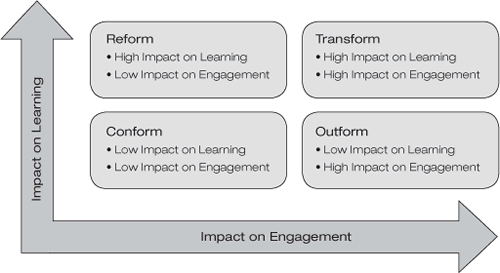Curriculum Brainstorming: Help Transform This ELA Lesson!

I’d like to invite you to a curriculum brainstorming party I’m having.
I was recently working with Middle School ELA teachers around ways to engage their students in reading and writing beyond the traditional zones. When I have these instructional brainstorms, I’m looking to push teachers to plan for high levels of both learning and engagement, what I call the “Transform” zone.
This zone is represented in the Matrix below:
Image credit: ASCD, 2013
You can read more about the Transformation Matrix at ASCD’s web site, where the first chapter of my and Janet Hale’s book Upgrade Your Curriculum (2013) is open for all to read.
During the session with the ELA teachers, and subsequently in a discussion with two educators on Twitter, I broached the topic of using current popular music and a song’s associated music video as a way to engage close reading of text, comparative analysis, and the use of digital tools. The teachers and I discussed using the singer Lorde’s song “Royals” and we started mapping out a close reading lesson.
Join me in creating a short unit
Over the next few days, I thought more about situating this lesson into a short unit that would involve additional informational texts and comparative analyses, as well as an opportunity for students to demonstrate their learning through the use of new digital tools, offering them varying versions of both the writing and the visualization of their work.
The unit that I’m currently creating is available on Curriculum 21’s Public Rubicon Atlas Mapping System for you to view. Note that it is in a state of creation. It is not a finished product. This blog post is meant to be the impetus for continued upgrades and an act of virtual professional development. This particular blog is not just about the consumption of the information I’m sharing.

Also be aware that while this unit is set to 8th grade standards, there are not huge gaps in sophistication of the Common Core standards from 6th through 8th grade. Based on the language of the standards, what would need to be nuanced in the unit plan to make it more appropriate for a different grade level? (This could even prompt a discussion of changing the suggested resources!)
Anything you feel that should be added or even deleted from this unit is valuable to share here. I’d like for you to share your contributions and comments in the comment section below. If I use any of your ideas in the unit, I will code that contribution in a different color and give you credit on the Rubicon Atlas map, preferably with your Twitter ID if you choose to include it. (Note the couple of examples where that has already happened.)
Let’s construct something awesome together. We have these tools and the expertise and we can collaboratively do great things. Come join me!
Mike Fisher will join presenters Heidi Hayes Jacobs, Bill Sheskey, Janet Hale and others for LEAD 21: Upgrading Curriculum and Embracing the New Literacies, a March 12-14, 2014, ASCD Pre-Conference Institute.
Mike is a contributor to the new Solution Tree series, Contemporary Perspectives on Literacy, which tackles global, media, and digital literacy. In addition to 2012’s Upgrade the Curriculum, written with Janet Hale, Mike is the author of the 2013 ASCD/Arias book Digital Learning Strategies: How Do I Assign And Assess 21st Century Work? Find Mike on Twitter @fisher1000 and visit his website The Digigogy Collaborative. His other MiddleWeb guest articles are here.




































Share your ideas about the “Royals” close reading lesson here in the Comments. You can check out the evolving lesson plan at the Rubicon Atlas site!
Mike
I am trying to digest the amount of information in your curriculum map.
Using the song is smart, as kids (least for now) will have it in their heads because it is on the radio (although less so already, with Lourde’s Team now on every hour).
My only thoughts would be to give some background to how she recorded it (she was rejected by record companies so she did it mostly on her own, with a producer, I believe) and how she didn’t quite come out of the blue (her parents have connections, I believe).
Whether she authentically voices youth or is only chosen by the media to be the voice of youth is a perpetual question that students rarely even consider.
I like the media analysis sections.
Having students make their own videos is excellent (if time consuming) and if they are writing their own songs, capturing what it means to be young in this day and age, even better. I just read an article about Green Day and their Dookie album, and how all of the lyrics were meant to capture what it meant for them to be young and “street rats” in their time period.
Every generation …
Peace,
Kevin
Kevin,
Thank you so much for you awesome comments! I’m based primarily in New York (thus the unintended focal point sometimes for my design) and your comments speak to some of the nuances that I’m seeing in other states around critical thinking through perspective analysis, in your case, namely biographical lenses. Many states have added additional standards to the Common Core to supplement what was there and some of those added standards include connections to just what you’re describing.
I appreciate your thoughtful comments and will be adding some of them to the map!
Thank you!
-Mike Fisher
Mike-
I am impressed and intrigued by your work! I teach 5th grade social studies so this is a bit out of my range of usefulness in my classroom but I still had some thoughts when I looked at your work.
As a differentiation could you offer a comparison to songs from other decades that have similar themes, 50s, 60s 70s Just so we get the idea that teen angst and adolescence is timeless. Or, a connection to Hinton’s “The outsiders” comes to mind.
I worked with Heidi Jacobs in a curriculum class 20 years ago at TC. I take the skills of creating units with big essential questions to heart. I am constantly trying to incorporate relevance into the curriculum. I know students presented with this opportunity to use a familiar song, will master these skills to a great degree.
Exciting stuff you have here! Good luck with your unit and your upcoming presentation. I also think that your request through this forum for collaboration points out an exciting use of technology to enhance collaborative curriculum planning.
Sincerely
Holly Procida
Thank you for your response Holly! I completely agree with the notion of integration and looking at teen angst across the ages. (And I LOVE the Outsiders!) Your suggestions might make the unit a longer one, though it could potentially tie in a new anchor text, such as a novel like the Outsiders. That, in turn, would necessitate additional supporting texts, new formative assessments and a shift in the summative project. This is awesome. Thanks for collaborating with me!
Mike,
What a wonderful way to both engage students as well as a broader community of educators!
Another angle to add to the Close Reading Assignment could be to do an activity where the students view the music video without the music. Have kids focus on the images, the length of the frames, etc. Students could jot down what they observe and afterwards discuss the effects and the significance in groups, in a Socratic seminar, or compose a short essay. It could lead to some wonderful conversations around literary devices such as tone, mood, imagery and symbolism.
Hey, Mike,
This is a really good idea to get students interested in ELA. Until recently, I was working with 10th graders and I did something similar.
I used Justin Timberlake’s Mirror for the task. The first thing I did was hand incomplete lyrics worksheets (as my students are ELA/ELL) so they could complete the lyrics as they listened to the song three different times. Then we talked a little bit about Justin Timberlake and his album 20/20 in order to provide background/context.
I had the kids identify the tone or attitude, the purpose, the audience and occasion, the appeal (whether JT used Logos, Ethos, or Pathos), the style (how JT communicated his message—rhetorical mode and rhetorical devices), etc. and to wrap things up I had the students create a Lyric video of their own.
One group chose a recent song and the other group chose a song that was out before they were born (I gave them the freedom to do so, as long as the lyrics were appropriate for a school environment-plus, I work at a Muslin school). You can check the videos here:
“I’ll Be There for You” by The Rembrandts: http://www.youtube.com/watch?v=5meSHMny9W8
“It’s Always a Good Time” by Carly Rae Jepsen and Owl City: http://www.youtube.com/watch?v=srPDvRiyEuM
They created the videos using a free iPhone app called VideoStar, which makes the editing process a no-brainer. The only requirement is that the song they chose was obtained legally, otherwise the app does not allow them to use it.
Hope it helps!
Cheers,
Moi De Castro (from Panama)